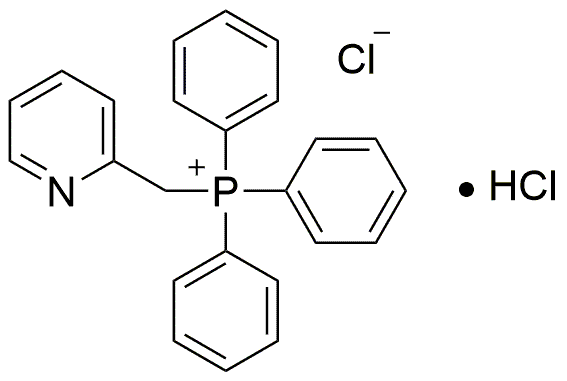Triphenyl(2-pyridylmethyl)phosphonium chloride hydrochloride is widely utilized in research focused on:
- Synthesis of Organophosphorus Compounds: This compound serves as a key reagent in the synthesis of various organophosphorus compounds, which are important in agriculture for developing pesticides and herbicides.
- Catalysis in Organic Reactions: It acts as a catalyst in several organic reactions, enhancing reaction rates and selectivity, which is beneficial for chemists looking to optimize their processes.
- Biological Research: The compound is used in studies related to cell signaling and membrane transport, providing insights into cellular mechanisms that can lead to new therapeutic strategies.
- Material Science: It finds applications in the development of advanced materials, particularly in the creation of conductive polymers and nanocomposites, which are essential in electronics and energy storage.
- Pharmaceutical Development: Researchers utilize this chemical in drug formulation and delivery systems, leveraging its properties to improve the efficacy and bioavailability of pharmaceutical compounds.
General Information
Properties
Safety and Regulations
Applications
Triphenyl(2-pyridylmethyl)phosphonium chloride hydrochloride is widely utilized in research focused on:
- Synthesis of Organophosphorus Compounds: This compound serves as a key reagent in the synthesis of various organophosphorus compounds, which are important in agriculture for developing pesticides and herbicides.
- Catalysis in Organic Reactions: It acts as a catalyst in several organic reactions, enhancing reaction rates and selectivity, which is beneficial for chemists looking to optimize their processes.
- Biological Research: The compound is used in studies related to cell signaling and membrane transport, providing insights into cellular mechanisms that can lead to new therapeutic strategies.
- Material Science: It finds applications in the development of advanced materials, particularly in the creation of conductive polymers and nanocomposites, which are essential in electronics and energy storage.
- Pharmaceutical Development: Researchers utilize this chemical in drug formulation and delivery systems, leveraging its properties to improve the efficacy and bioavailability of pharmaceutical compounds.
Documents
Safety Data Sheets (SDS)
The SDS provides comprehensive safety information on handling, storage, and disposal of the product.
Product Specification (PS)
The PS provides a comprehensive breakdown of the product’s properties, including chemical composition, physical state, purity, and storage requirements. It also details acceptable quality ranges and the product's intended applications.
Certificates of Analysis (COA)
Search for Certificates of Analysis (COA) by entering the products Lot Number. Lot and Batch Numbers can be found on a product’s label following the words ‘Lot’ or ‘Batch’.
Numéro de catalogue
Numéro de lot/série
Certificates Of Origin (COO)
This COO confirms the country where the product was manufactured, and also details the materials and components used in it and whether it is derived from natural, synthetic, or other specific sources. This certificate may be required for customs, trade, and regulatory compliance.
Numéro de catalogue
Numéro de lot/série
Safety Data Sheets (SDS)
The SDS provides comprehensive safety information on handling, storage, and disposal of the product.
DownloadProduct Specification (PS)
The PS provides a comprehensive breakdown of the product’s properties, including chemical composition, physical state, purity, and storage requirements. It also details acceptable quality ranges and the product's intended applications.
DownloadCertificates of Analysis (COA)
Search for Certificates of Analysis (COA) by entering the products Lot Number. Lot and Batch Numbers can be found on a product’s label following the words ‘Lot’ or ‘Batch’.
Numéro de catalogue
Numéro de lot/série
Certificates Of Origin (COO)
This COO confirms the country where the product was manufactured, and also details the materials and components used in it and whether it is derived from natural, synthetic, or other specific sources. This certificate may be required for customs, trade, and regulatory compliance.


